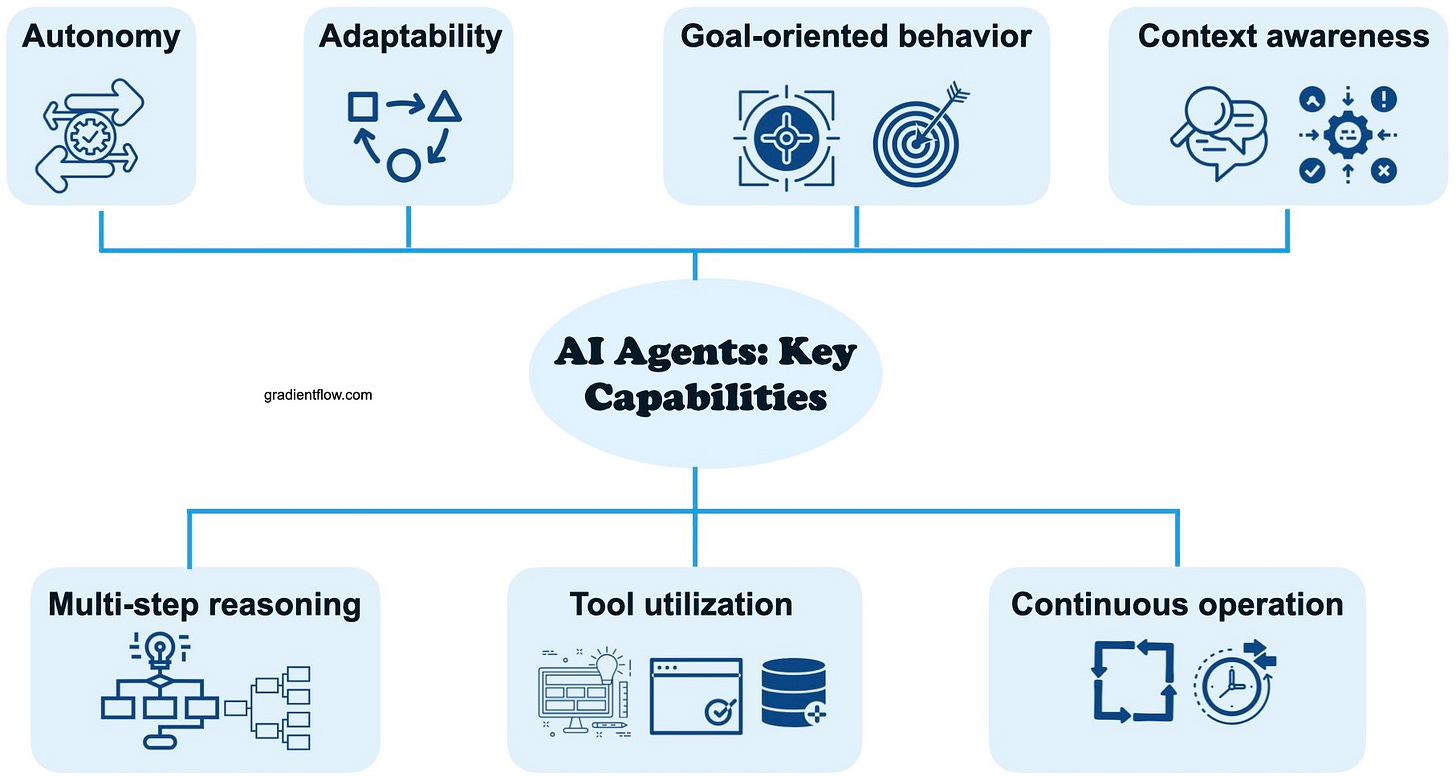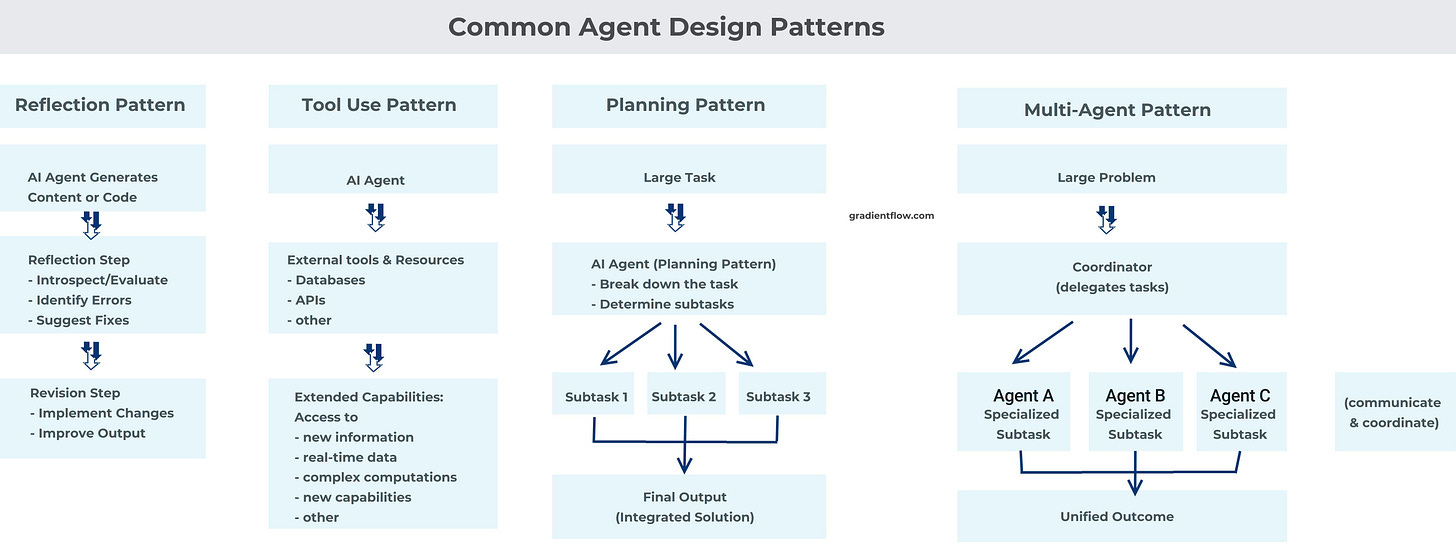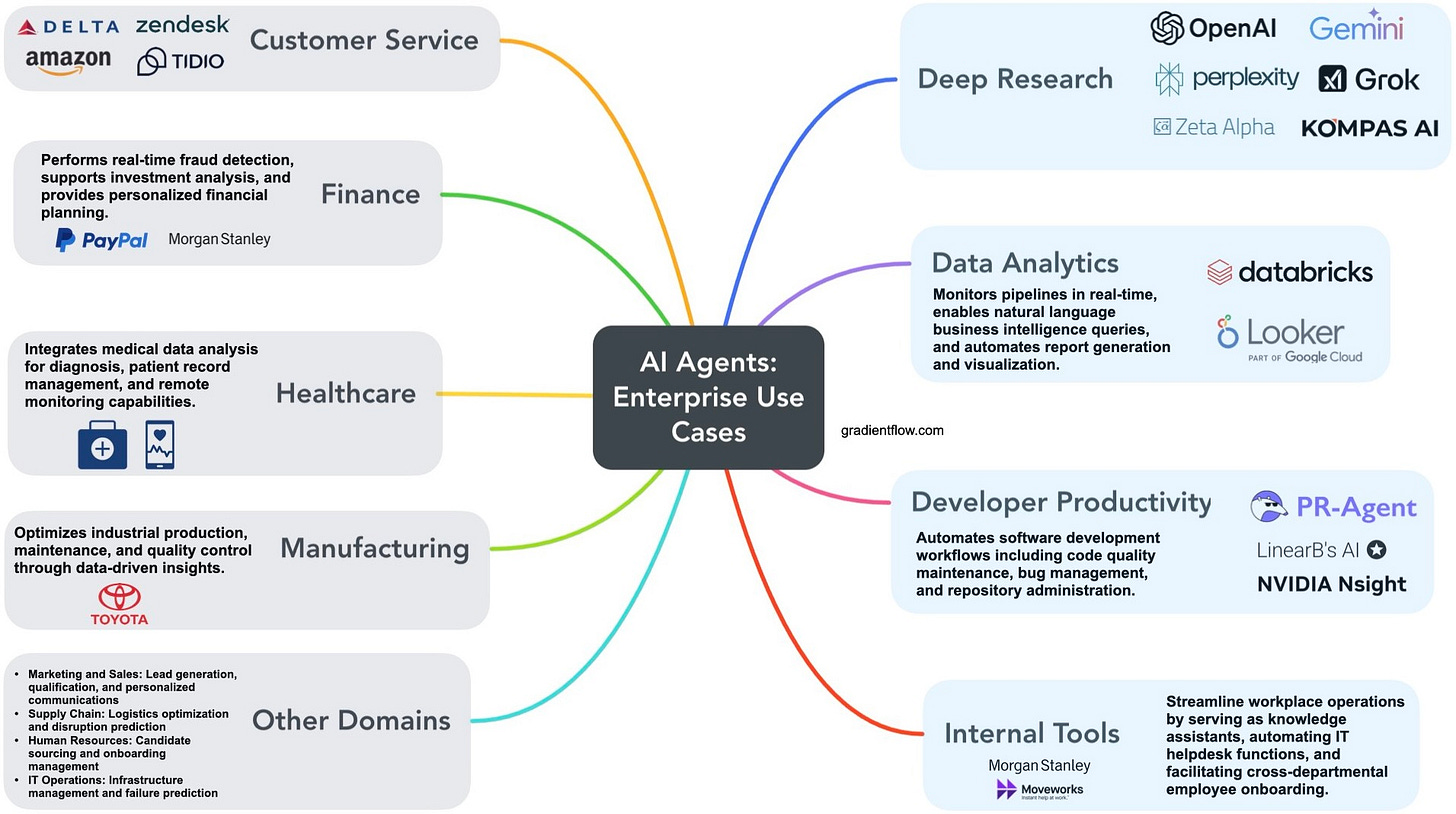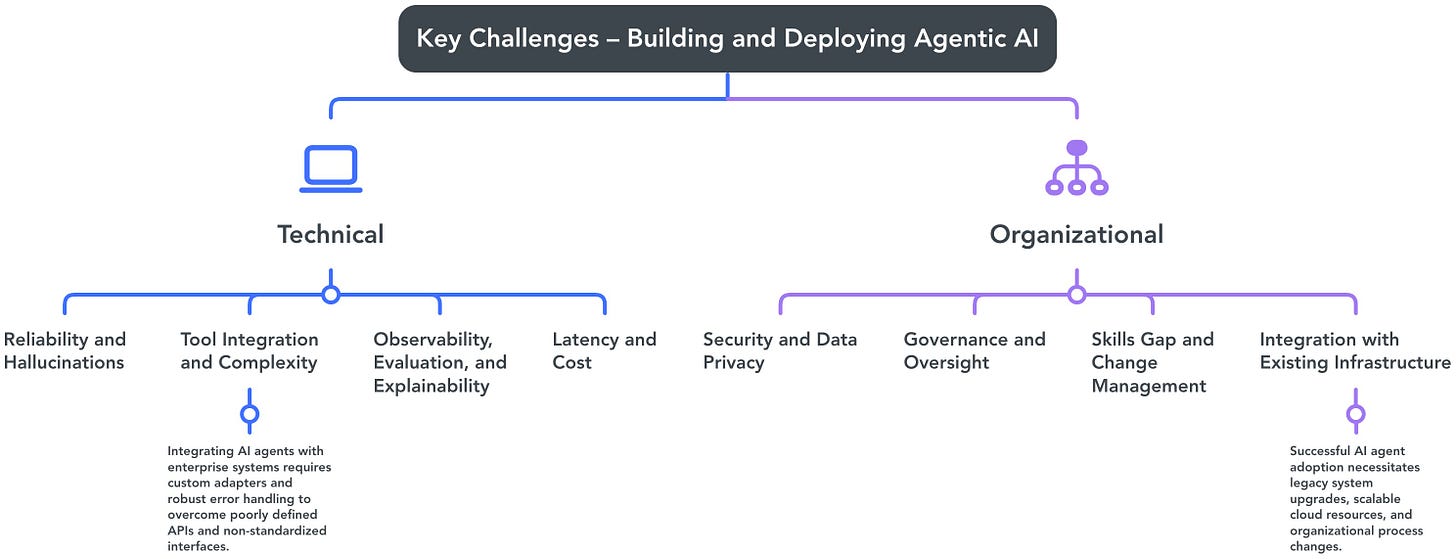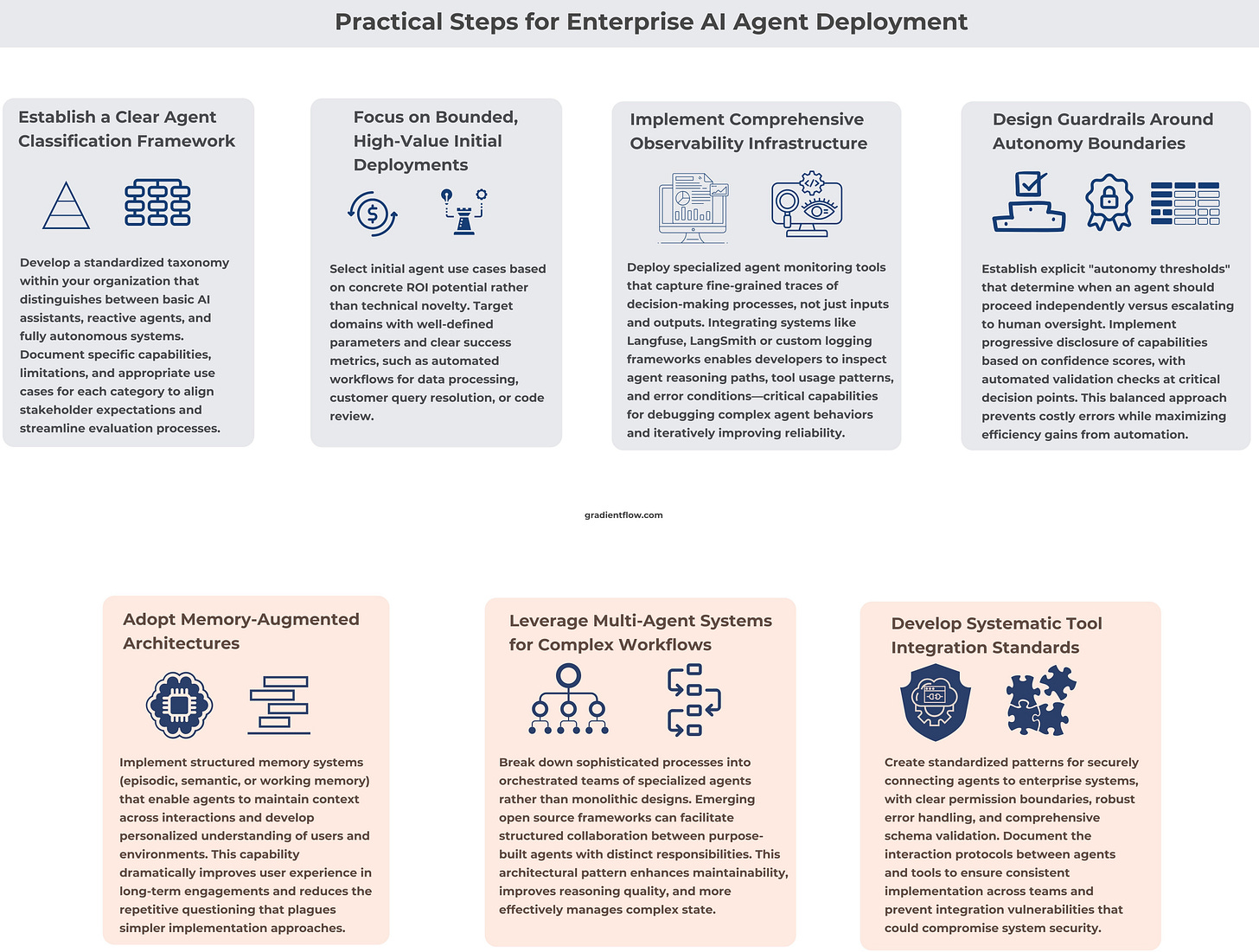Agents at Work: Navigating Promise, Reality, and Risks
Agents are top of mind for people working in AI. Still, when I talk to professionals building AI applications, many express frustration, highlighting the gap between the intense interest in agents and their relatively limited presence in live enterprise environments. Part of this skepticism is justified—as evidenced by the systemic failure modes we recently explored in multi-agent systems, translating agent potential into reliable enterprise performance remains a significant hurdle. Furthermore, confusion around what exactly constitutes an "agent" is rampant. Companies like Microsoft, OpenAI, and Salesforce use the term loosely, describing everything from basic chatbots to sophisticated autonomous systems. Definitions shift constantly, stakeholders emphasize different capabilities—such as autonomy or workflow orchestration—and technical teams often struggle to evaluate these products due to ambiguous expectations.
What most serious technologists mean by "agent" is something quite specific: an autonomous software system capable of perceiving its environment, reasoning through complex problems, and taking independent actions to achieve defined goals. Unlike traditional AI systems that simply execute predetermined instructions when prompted, agents exhibit genuine autonomy, adapt to changing circumstances, maintain context across interactions, and employ multi-step reasoning to tackle problems. They proactively pursue objectives rather than merely responding to queries—a fundamental distinction that separates truly agentic systems from their more primitive counterparts.
Go deeper: Upgrade for members-only articles & extras! 🚀
Such definitions become clearer when examining the real-world implementations already in operation. Readers familiar with deep research tools—which we examined in a previous piece—have already interacted with specialized agents in action. These tools autonomously conduct sophisticated investigations by breaking down queries, gathering and analyzing diverse sources, and dynamically adjusting their approach—showing precisely the proactive, context-aware behavior that agents promise. Though still nascent, such tools provide a compelling glimpse of what mature agents could accomplish across broader domains.
These “deep research” examples merely scratch the surface; enterprise applications of agents are already far more diverse—and pragmatic—than many skeptics acknowledge. Beyond the research tools mentioned above, there are already agent deployments transforming core business functions across industries with little fanfare. Morgan Stanley's internal advisor assists financial analysts with complex queries, while Zendesk's AI agents handle customer inquiries with contextual awareness that transcends simple chatbot functionality. In software development, tools like PR-Agent autonomously conduct code reviews and suggest improvements, displaying precisely the kind of goal-oriented reasoning that defines true agents. These implementations aren't merely theoretical constructs—they're operational systems driving measurable efficiency gains in environments where mistakes carry real consequences.
The most compelling deployments often appear in specialized domains where the stakes are highest. Toyota's multi-agent systems have slashed production planning time by 71%, demonstrating genuine autonomy in manufacturing environments. Healthcare applications, like diagnostic assistants that analyze medical data to support clinical decisions, showcase the potential for agents to augment expert judgment rather than simply automate rote tasks. What distinguishes these applications is their capacity for self-directed reasoning within carefully defined parameters—they don't just respond to prompts but actively work toward outcomes through multi-step processes. For enterprise leaders, the most relevant question isn't whether agents exist in production, but rather which specific business problems are most amenable to agent-based approaches. Early implementations suggest a range of untapped opportunities across business functions.
Despite these encouraging examples, enterprise adoption of agentic AI faces significant hurdles, not just technical, but also organizational and operational. I've seen firsthand how reliability concerns become magnified in corporate settings—agents that perform admirably in controlled demonstrations falter when confronted with the messy reality of enterprise data and workflows. The compounding error problem is particularly insidious; when an agent chains multiple reasoning steps or tool calls, success rates can plummet to 60-70% even for well-designed systems. For enterprises where errors translate directly to financial or reputational damage, this presents an uncomfortable risk profile that frequently relegates agents to low-stakes functions rather than mission-critical operations.
Support our mission and get premium content in return! 🙏
The organizational challenges, however, often prove even more intractable than the technical ones. Security incidents like Samsung's recent data leak vividly illustrate how agent autonomy can rapidly transform from competitive advantage to liability. Many enterprises lack the governance frameworks necessary to manage these risks, creating a precarious situation where "shadow AI" deployments proliferate without proper oversight. The skills gap compounds these issues—there simply aren't enough professionals who understand both the technical nuances of agent systems and the business domains where they're being deployed. Without significant investment in retraining programs and thoughtful change management strategies, even technically sound agent implementations risk being undermined by organizational resistance or operational misalignment. The question for enterprises isn't whether agents offer transformative potential—they clearly do—but whether organizations can evolve their infrastructure, governance, and culture rapidly enough to realize it.
Beyond these hurdles, agent technology continues to demonstrate encouraging progress toward practical implementation. We're seeing improvements in multi-agent frameworks that empower enterprises to orchestrate complex workflows without the technical overhead once required. Enhanced memory capabilities promise greater contextual awareness and deeper personalization, which could make agents not just useful assistants but indispensable business collaborators. The combination of more robust reasoning methods, standardized reliability measures, and hybrid architectures blending data-driven and symbolic approaches suggests a near future where practical deployments become both safer and more commonplace.
What will truly distinguish industry leaders from those left behind goes beyond mere technological adoption. The companies that thrive will need to reimagine their organizational structures around human-AI collaboration rather than treating agents as mere cost-cutting automation tools. This demands new governance frameworks, security protocols, and perhaps most critically, a workforce trained to operate as effective partners to increasingly autonomous systems. The businesses that succeed will be those prepared not merely to adopt new technologies, but to fundamentally rethink how people and autonomous systems work together.
Act now to join the AI Agent Conference in NYC, May 6-7—tickets are nearly sold out.
Data Exchange Podcast
2025 Artificial Intelligence Index. Stanford HAI Research Manager Nestor Maslej breaks down the 2025 AI Index Report, revealing how inference costs for AI models have plummeted 280 times in just 18 months and exploring the intensifying US-China competition in artificial intelligence development.
How AI is Transforming Talent Development. Workera founder Kian Katanforoosh explores the massive growth in the skills verification market and how AI is revolutionizing assessment creation and adaptation. He explains how Workera is using AI throughout the assessment workflow while maintaining human oversight to ensure validity.
Ben Lorica edits the Gradient Flow newsletter. He helps organize the AI Conference, the AI Agent Conference, the NLP Summit, Ray Summit, and the Data+AI Summit. He is the host of the Data Exchange podcast. You can follow him on Linkedin, Mastodon, Reddit, Bluesky, YouTube, or TikTok. This newsletter is produced by Gradient Flow.



